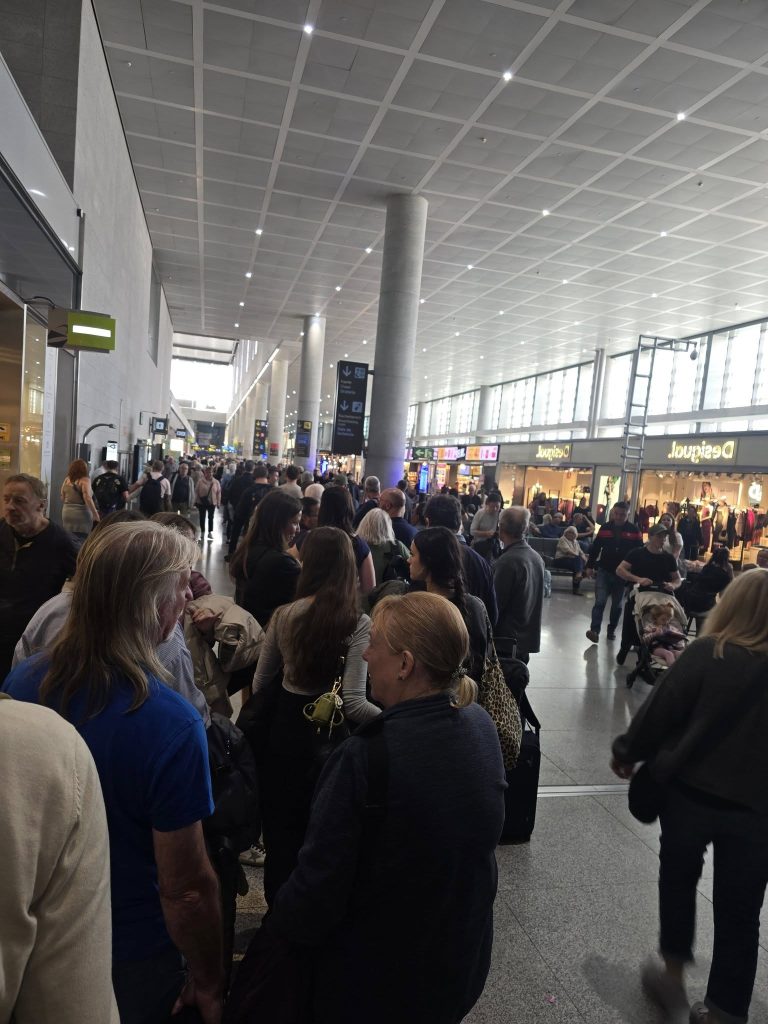It’s no secret that the phased rollout of the EU’s Entry/Exit System (EES) has seen some chaotic episodes in Spain.
With conflicting information and a lack of preparedness in some airports, Brits and other third nationals have missed flights and been forced to queue for up to two hours at passport control.
Here, the Spanish Eye lays out everything you should know about using the EES in Spain.
What is the EES?
Under the EES, anyone from a non-Schengen or ‘third country’ – including the UK – must use biometric scanners upon entering and exiting the EU to keep track of the number of days they have spent in the bloc (ensuring they don’t exceed their 90 in 180 day limit).
As the system has just begun, Brits and others are using the machines for the first time, and are having to register their fingerprints and face scans, leading to delays when they are up and running at peak times.
When are peak times?
Anyone who is a non-EU national arriving or leaving Spain should allow for plenty of time.
Those travelling at peak times should be aware that they may face significant delays if their airport is using the EES machines.
As they are being phased in, they are not switched on 24/7 and not every single third national is asked to use them, to avoid completely overwhelming the airports.
Unfortunately, it seems to be a bit of a lottery as to whether or not you will face the snaking queues.
Over the past few weeks, the largest number of complaints have been during the weekends, specifically the early mornings and evenings of Friday, Saturday and Sunday.
Anyone due to leave Spain at these times should arrive at the airport extra early.
What happens at arrivals?
You will be guided to the EES machines (if in operation) and have your fingerprint and face scanned.
This biometric data will then be stored in the EU’s database for three years after your last entry or exit. It will be deleted if you do not travel to the Schengen within that time.
In Spain, passengers are often being guided to manual passport checking after using the scanners to have their passport stamped.
This can happen, and the British Embassy has previously said that there will be variations between airports and ports.
Once the EES is fully rolled out, the manual passport checking will become obsolete.
There will be delays at peak times, as travellers are not used to the machines, and the process is far from streamlined.
Additionally, the passport desks can be understaffed, causing painful delays – a problem that has existed long before the EES rollout.

What happens at departures?
At departures, non-EU passport holders will be guided to their own queue featuring the biometric scanners.
If you are already registered on the EES, then head to a ‘pre-registration kiosk’ that will speed up the process.
People registering for EES for the first time can also use these self-serving kiosks, which are typically located near to the passport queues.
However, be aware that only people with biometric passports (those that contain a chip) can use them.
Once you have registered on the pre-registration kiosks, you can go straight through to the e-gates, or in some cases manual checks by border officers (the machine will tell you which).
Neil Storey, a Brit travelling back to the UK via Malaga, wrote earlier this month: ‘You can use the scanners to the right near the windows before the queue and then go through the e-gates to avoid the queue.
‘I only found this out after queuing for an hour. Our Jet2 to Newcastle today left 20mins late and left some behind.’
Jimmy Blackman, also travelling from Malaga, added: ‘I realised that you can register your passport on the machines to the right of the queue and then literally walk straight through the EU section on the right hand side and straight through to the gate… it shaved at least an hour off the queue, but the sign posting and awareness is terrible.’
How to use the pre-registration kiosks
- Present yourself alone in front of the kiosk
- Click on the home screen to start your pre-registration and follow the instructions
- Fill in the form about your personal information and your trip
- Place your passport on the photo page at the top left of the reader and hold the document on the reader until the device informs you that the capture is successful. Depending on your situation, you may be asked to scan the visa you have
- Prepare to take your facial image: remove your glasses, scarf, hat and mask
- Stand in front of the camera and help yourself with bright LEDs in order to take the photo successfully
- Prepare for the registration of your fingerprints: press the four fingers of your right hand on the reader. If it is not possible to use the right hand, you can use the left hand
- At the end of your pre-registration, the kiosk screen will direct you to the rest of the route to complete your border crossing
What if you are a resident of Spain with a TIE card?
One of the most confusing parts of the EES relates to Brits and other third country nationals who are residents in Spain and have a TIE card.
What all authorities agree on is that residents of the EU are exempt from the EES’s rules and do not need to fear staying over the 90-day limit.
However, there is currently conflicting practices at different airports over whether they can join the EU nationals’ queue at passport control and avoid the process.
The EU itself makes it clear on its EES FAQs webpage: ‘UK nationals and their family members who are beneficiaries of the Withdrawal Agreement will be exempt from registration in the EES only if they hold a specific residence document’, which includes a TIE.
The Policia Nacional in Malaga has also backed this up, confirming that if you hold a TIE card, you are permitted to use the EU queue.
The force told the Spanish Eye: ‘UK citizens with a Residence Permit and therefore a Foreigner Identity Card (TIE) can use the queues designated for EU citizens.

‘However, these queues are managed by AENA (Spanish Airports and Air Navigation) staff, not the National Police, which could lead to confusion or disruption.
‘UK passengers meeting the aforementioned conditions should be aware of this in order to proceed to the correct queue and avoid procedures that could generate errors in the European Entry/Exit System, which, as you may know, began operating at Malaga-Costa del Sol Airport on October 20, 2025.’
They added: ‘Officials at the aforementioned airport have confirmed that they have contacted the various consulates to provide them with information regarding the updates to the Entry and Exit System (EES).’
But causing confusion, a spokesperson from Spain’s Interior Ministry later told the Spanish Eye that TIE holders should use the EES, as did Policia Nacional in Alicante – although in the Costa Blanca airport, many TIE holders have been ushered through the EU queue (while many haven’t, highlighting the lack of consensus and poor training of staff).
An Interior Ministry spokesperson told this paper: ‘British citizens must use the Entry-Exit System intended for third countries.’
However, it added: ‘If you have a TIE (Foreigner Identity Card)… the 90-day maximum stay period applicable to citizens entering with visas will not apply.’
So what does this mean in practice for TIE holders?
If you hold a TIE card, you SHOULD be exempt from registering in the Entry/Exit System.
However, due to the ongoing confusion at some airports, you may not be allowed to join the EU queue and be told to register.
If they direct you to the EES machines, try not to panic, as the Interior Ministry has insisted the 90-day limit will not apply to you.
Just make sure you are always carrying your TIE when travelling in and out of the Schengen area.
If your data is stored incorrectly in the system, it can be deleted or amended at a later date as long as you can show valid proof of your residency.
Additionally, according to footage of a pre-registration kiosk at Prague, taken by UK travel expert Simon Calder, the self-service machines will ask you whether or not you hold a long-term residency in an EU country, to which you can reply ‘yes’ before providing more details.








